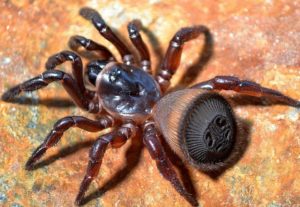Meet the Chinese Hourglass spider! It’s part of the Halonoproctidae spiders family and has a super unique look with a special disk at the end of its tummy. Join us as we share awesome facts about this one-of-a-kind spider!

Cyclocosmia ricketti
The eggs are laid inside the caves, which they protect by using the coin-shaped disk on their abdomen to block the entrance to their burrow, in a process called phragmosis.
As spiderlings are rarely seen outside the tunnels, very little is known about their appearance. They emerge from the burrow after they mature.
Like other trapdoor spiders, they are not great at constructing webs. They use the silk threads they generate to line their tunnels.
Yes, Chinese Hourglass spiders have venom. They use it to catch their food, like tiny bugs. Most people don’t need to worry about it.
They sure can! But these spiders are usually not aggressive. They might bite if they’re really scared and their bite is painful.
The Chinese Hourglass spider contributes significantly to the control of insect populations, serving as natural pest management. Their unique burrowing and defensive behaviors also play a role in soil aeration and nutrient cycling.
Natural Predator: Natural predators such as scorpions and parasitic wasps pose a threat to these spiders, often breaching their burrow defenses.
Prey-Predator Dynamics: As predators, Chinese Hourglass spiders help maintain a balanced ecosystem by controlling insect populations. Their own survival tactics, including the distinctive use of phragmosis, are a testament to the evolutionary arms race between predators and prey.
Relationship with Humans: Humans rarely encounter these elusive spiders, but their rarity and unique appearance have made them highly sought after by collectors, impacting their numbers in the wild. The ethical implications of their trade and collection highlight the need for conservation efforts.
| Other names | Money Trapdoor Spider, Money Living-Door Spider, Severed Abdomen Spider |
| Lifespan | 5-10 years |
| Distribution | China, mainly the provinces of Fujian, Sichuan, and Zhejiang |
| Habitat | Caves |
| Common Predators | Scorpions and wasps |
| Diet | Insects such as ants, beetles, crickets, cockroaches, grasshoppers, and moths |
In summary, the Chinese Hourglass spider is not just an arachnid with an intriguing appearance; it plays a pivotal role in its ecosystem.
Image Source: reptileforums.co.uk, myhourglasscollection.com, live.staticflickr.com
Meet the Chinese Hourglass spider! It’s part of the Halonoproctidae spiders family and has a super unique look with a special disk at the end of its tummy. Join us as we share awesome facts about this one-of-a-kind spider!

Cyclocosmia ricketti
The eggs are laid inside the caves, which they protect by using the coin-shaped disk on their abdomen to block the entrance to their burrow, in a process called phragmosis.
As spiderlings are rarely seen outside the tunnels, very little is known about their appearance. They emerge from the burrow after they mature.
Like other trapdoor spiders, they are not great at constructing webs. They use the silk threads they generate to line their tunnels.
Yes, Chinese Hourglass spiders have venom. They use it to catch their food, like tiny bugs. Most people don’t need to worry about it.
They sure can! But these spiders are usually not aggressive. They might bite if they’re really scared and their bite is painful.
The Chinese Hourglass spider contributes significantly to the control of insect populations, serving as natural pest management. Their unique burrowing and defensive behaviors also play a role in soil aeration and nutrient cycling.
Natural Predator: Natural predators such as scorpions and parasitic wasps pose a threat to these spiders, often breaching their burrow defenses.
Prey-Predator Dynamics: As predators, Chinese Hourglass spiders help maintain a balanced ecosystem by controlling insect populations. Their own survival tactics, including the distinctive use of phragmosis, are a testament to the evolutionary arms race between predators and prey.
Relationship with Humans: Humans rarely encounter these elusive spiders, but their rarity and unique appearance have made them highly sought after by collectors, impacting their numbers in the wild. The ethical implications of their trade and collection highlight the need for conservation efforts.
| Other names | Money Trapdoor Spider, Money Living-Door Spider, Severed Abdomen Spider |
| Lifespan | 5-10 years |
| Distribution | China, mainly the provinces of Fujian, Sichuan, and Zhejiang |
| Habitat | Caves |
| Common Predators | Scorpions and wasps |
| Diet | Insects such as ants, beetles, crickets, cockroaches, grasshoppers, and moths |
In summary, the Chinese Hourglass spider is not just an arachnid with an intriguing appearance; it plays a pivotal role in its ecosystem.
Image Source: reptileforums.co.uk, myhourglasscollection.com, live.staticflickr.com